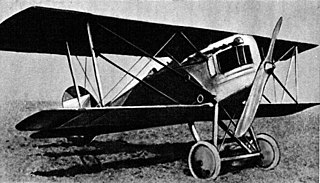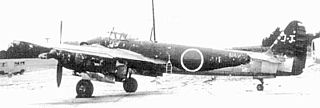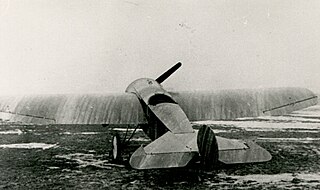
The Bell XP-83 was a United States prototype jet escort fighter designed by Bell Aircraft during World War II. It first flew in 1945. As with most early first generation jet fighters, the design was hampered by a relative lack of power. With the rapid advancements in jet technology post-WWII, the XP-83 was soon eclipsed by more advanced designs and it never entered production.
The Rikugun Ki-202 Shūsui-Kai was a direct development of the German Messerschmitt Me 163 Komet rocket-powered interceptor aircraft. None were produced before Japan's surrender that ended World War II.

The Nakajima Ki-201 Karyū was a Japanese jet fighter aircraft-attack aircraft project designed during the final stages of World War II but which was never completed.
The Dassault Étendard VI was a French prototype fighter aircraft initially developed as part of the NATO NBMR-1 competition to find a standard fighter to serve amongst member air forces. Dassault took advantage of the fact that the French Air Force had issued a requirement around the same time for a new fighter-bomber and developed aircraft in parallel as variations of the same design concept for the two prospective customers.

The AEG D.I was a biplane fighter of World War I. Three prototypes were ordered, but after the first two were involved in serious crashes, one of which killed flying ace Walter Höhndorf on September 5, 1917, development was cancelled. A triplane version was built as the Dr.I. The second and third prototypes differed little from the first except in detail.

The Aero A.18 was a biplane fighter aircraft built in Czechoslovakia in the 1920s. It was a development of the Ae 02 and Ae 04 fighters Aero had designed during World War I, but also borrowed from the more recent A.11 reconnaissance-bomber design.

The Aero A.20 was a biplane fighter aircraft built in Czechoslovakia in 1923. It was evaluated for Czechoslovak Air Force service against Aero's competing A.18 and A.19 designs, a competition that the A.18 won, meaning that this aircraft never entered production, and only a single prototype was ever built.

The Seversky XP-41 was a fighter aircraft built in the United States in 1939. A single prototype was modified from the last production Seversky P-35 by adding a new streamlined canopy, a Pratt & Whitney R-1830-19 engine with a two-speed supercharger, and revised landing gear. The XP-41 first flew in March 1939. The aircraft was developed in parallel with the P-43 Lancer, and work was stopped when the USAAC showed a preference for the latter.

The Nakajima J5N was an abandoned Japanese prototype fighter aircraft of the World War II era. J5N was developed as twin-engine interceptor for countering attacks by Boeing B-29 Superfortress.
The Focke-Wulf Ta 153 (GH+KV) was a prototype German fighter aircraft built during World War II. It was a development of the Fw 190C, a Fw 190A with a DB 603A engine.

The Bell XP-77 development was initiated by the United States Army Air Forces during World War II to produce a simplified "lightweight" fighter aircraft using non-strategic materials. Despite being innovative, the diminutive prototype proved tricky to handle and the project was canceled when the XP-77 did not deliver its projected performance.

The Curtiss XP-46 was a 1940s American prototype fighter aircraft. It was a development of the Curtiss-Wright Corporation in an effort to introduce the best features found in European fighter aircraft in 1939 into a fighter aircraft which could succeed the Curtiss P-40, then in production.

The Curtiss XP-62 was a prototype single-engine interceptor aircraft, that was built for the United States Army Air Forces, by the Curtiss-Wright Corporation. It first flew in 1943.

The Republic XP-72 was an American prototype fighter-interceptor developed by Republic Aircraft as a progression of the P-47 Thunderbolt design. The XP-72 was designed around the Pratt & Whitney R-4360 Wasp Major 28-cylinder air-cooled radial engine with a supercharger mounted behind the pilot and driven by an extension shaft from the engine. The armament consisted of six .50 caliber (12.7 mm) wing-mounted Browning AN/M2 machine guns and underwing racks for two 1,000 lb bombs; Alternative armament packages included two 37 mm M4 autocannons with four .50 caliber AN/M2s, or four M4 autocannons.

The Vought XF3U was the prototype of a two-seat, all-metal biplane fighter, built by Vought Aircraft Company of Dallas, Texas for the United States Navy.

The Fokker V.17 and its derivatives were a series of experimental monoplane Fighter aircraft produced by the Dutch aircraft company Fokker in the 1910s.

The Hansa-Brandenburg W.19 was a German fighter-reconnaissance aircraft of World War I. It was a single-engined two-seat biplane floatplane, and was a larger development of the successful W.12. It served with the Kaiserliche Marine during 1918.

The Kawasaki Ki-28, World War II Allied reporting name "Bob", was an experimental fighter aircraft designed for the Imperial Japanese Army and meant as a replacement for the Kawasaki Ki-10. It flew in 1936, but was never produced for actual use as the Army chose the Nakajima Ki-27.

The Mitsubishi Ki-33 was an experimental monoplane fighter aircraft designed for the Japanese Imperial Army. Two prototypes flew in 1936 but the design never entered production.
The Mitsubishi J4M Senden or Navy Experimental 17-Shi Otsu B Type Interceptor Fighter Senden, Allied reporting name Luke, was a Japanese World War II fighter aircraft proposed by Mitsubishi Heavy Industries for use by the Imperial Japanese Navy. The J4M project did not proceed beyond the design stage.















